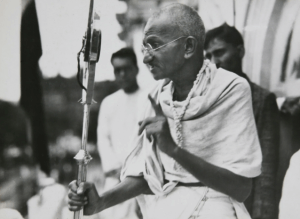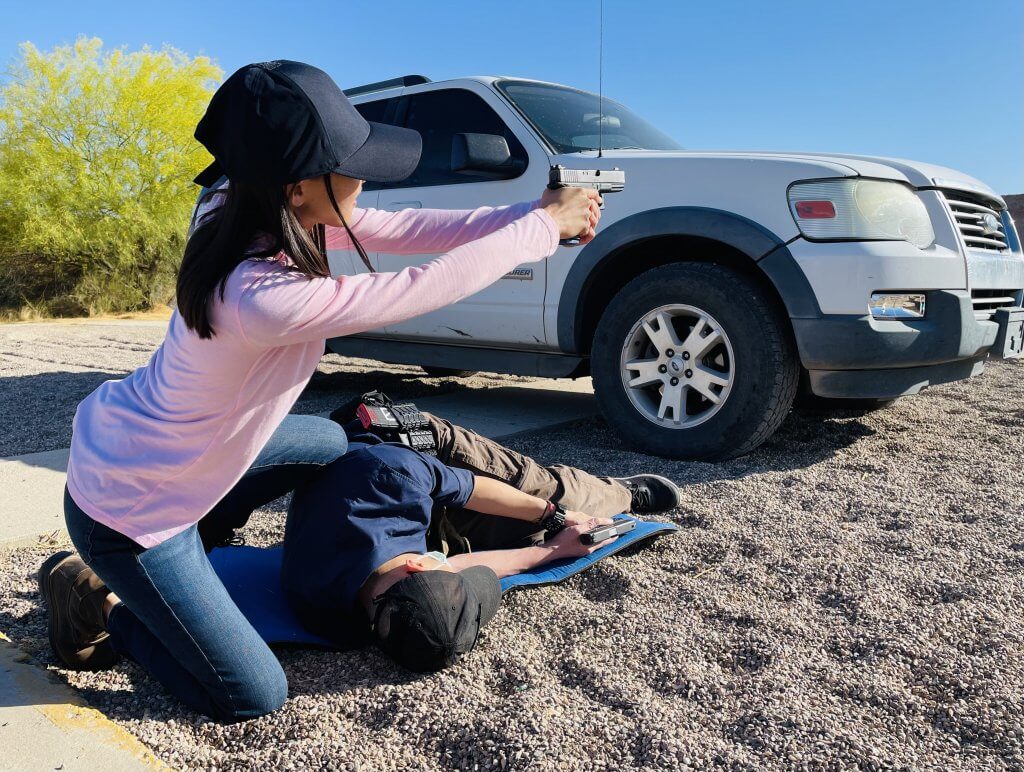Gandhi the Satyagrahi

I was raised to be a warrior protector, the way a bird dog is bred to hunt.
Other dads gave their sons baseball gloves. Mine gave me copies of Clausewitz and Sun Tzu. He was back from his third tour in Southeast Asia on my 11th birthday. Instead of going fishing, my father took me to fly an F-4 Phantom simulator–not a video game (those weren’t available to the common man in ’73); a real one, that the fighter pilots in his command trained in.
At my (first) college, the Air Force Academy in Colorado Springs, they told us that our main task, as military officers, would be the “management of violence.” Later, as a rifleman, I excelled at small unit tactics.
It might surprise you to learn, then, that the Mahatma Gandhi is someone I wish to emulate, more than many others. Gandhi was not just a 19th and 20th Century pacifist who practiced nonviolence. He was the definitive pacifist.
He’s at least somewhere in the top three pacifists in human history, that I’m aware of (the other two being Martin Luther King Jr and Jesus of Nazareth), all of whom preached nonviolence as a primary (key word, primary) means of solving human problems.

I’m pretty sure that if the Mahatma Gandhi was teaching a class on nonviolence to elementary schoolers when some payaso with a machete came in there and started chopping up those innocent kids, Gandhi would NOT just stand by, saying “Now remember children, an eye for an eye leaves the whole world blind. We must be the change we wish to see in the world.”
I’d bet my next pension check that even Gandhi would grab the nearest fire extinguisher or stapler or paperweight and get medieval on that idiot’s head, repeatedly, till the children were safe.

*****
Satyagrahis
Satyagraha is a Hindi and Sanskrit word meaning “holding on to truth.” Gandhi used satyagraha to mean a determined and ideally (but only ideally) nonviolent resistance to evil. Gandhi called one who resists evil a satyagrahi.
“He cannot be a satyagrahi who is afraid of death. The ability to use physical force is necessary for a true appreciation of satyagraha. He alone can practice ahisma [nonviolence] who knows how to kill, i.e., knows what hisma [violence] is.”
–the Mahatma Gandhi
Or, to put it more simply,
“Only a warrior can CHOOSE to be a pacifist; all others are condemned to it.”
–Tygh Thompson
According to Christian Bartolf, Gandhi told villagers they
“would be guilty of cowardice in failing to defend the honor of their womenfolk . . . by force of arms against kidnappers and others threatening their families. This attitude was, according to Gandhi, not only consistent with ahimsa, but a direct result of it.”
–“Gandhi and War: The Mahatma Gandhi / Bart de Ligt Correspondence,” published on the website of the Satyagraha Foundation for Nonviolence Studies, August 22, 2013
*****
Honor
Gandhi used the word “honor” there in its archaic sense, referring to a woman’s right to decide whom she permits to get intimate with her body. Although there never was anything dishonorable about being raped, protecting a woman or girl from being raped was called “defending her honor.” I’m certain that defending women from physical violence is what Ghandi was talking about.
The word honor sometimes also referred to a lady’s reputation regarding her voluntary sexual behaviors (rape, in contrast, is by definition involuntary, and is really about control, rather than sex). In the ye olde days, long before even I was born, if a man accused a woman of having “easy virtue,” the woman’s husband, father or brother might challenge the man to a duel to “defend her honor,” i.e., her reputation. Duels were an extreme form of mutually consenting social violence. I’m certain Gandhi would have frowned severely upon duelling.
Honorable behavior is conforming to your own code of ethics. No one can take your honor from you, although you can give it away, by yielding to temptation or corruption. Bar brawlers who claim they are fighting to “defend their honor” are really just trying to save face, which isn’t the same thing.
*****
Violence is Never the Answer. Well, um, I Mean, Mostly . . .
I was a precocious child; I remember arguing with a history teacher over the merits of the American P-51 Mustang vs the German Me-262 jet fighter in junior high.

When I was in elementary school, my teacher told us that violence never solved anything (pretty sure yours did, too). My hand shot up immediately.
“But what about the Civil War?” I asked. “Wasn’t that violence necessary, to end slavery, and to keep the States United?” She grudgingly admitted that it was.
Before the American Civil War, abolitionists had been making efforts to end slavery through literature (education), legislation, and / or Constitutional amendement. Americans elected Abe Lincoln, which was a step in the right direction. I am all for solving problems through democratic processes such as voting, debate, and compromise.

But once cannon shells started falling on Fort Sumpter, those efforts alone would not do. It took the most deadly war in American history (for Americans, that is) to end the evil of state-sanctioned slavery in the USA.

It could logically be argued that modern forms of slavery, such as trafficking for prostitution and peon wages for illegal immigrants, once again became state-sanctioned when the Biden Administration threw the gates of the USA wide open to unlawful immigration, allowing even criminal gang members to claim asylee status (after all, poor, persecuted MS-13 members, who literally had to hack humans to death to get into their gang, could be–gasp!–prosecuted in their country of citizenship), but that is for another blog.
Getting back on topic, I saw a bumper sticker that read
VIOLENCE NEVER SOLVED ANYTHING
In smaller print, below that, it said
. . . apart from slavery, monarchy, communism, insurrection, tyranny, civil disorder, and personal assault.
Jesus didn’t drive the money lenders out of the Temple courts in Jerusalem with kind words. According to the written record, He made a whip and lashed them, turning over their tables, till they fled.
“What happened to your face? Did that old man beat you up?”
–PCSO Deputy Bill Farmer, to the spree killer who shot Rep Gabby Giffords and over a dozen others on 08 Jan 2011

*****
Sometimes the First Resort
I’ve been teaching response to spree killings for decades. Every government agency training active violence response, almost without exception, has said “only fight as a last resort.”
Poppycock. Get a clear line of fire and shoot him in the head. Now.
Even if you are not packing heat, if the killer is in your space, fighting will probably be your first and most survival oriented (least dangerous) option. More importantly from a moral standpoint, it stops the killer, instead of simply moving him (it’s almost always a him) on to other victims, as barricading does.
Only recently have “Run Hide Fight” videos put out by the FBI, DHS, and other organizations started to admit that fighting might be your best option in some circumstances. They have even started explaining how: control the killer’s weapons while your comrades stave in the bad guy’s head with whatever blunt object is handy. I’ve been teaching students to delegate such specific fighting roles for decades.

The FBI reports a 50% drop (based on their definition) in spree killings in 2024, compared with the previous year. The numbers had been going up, almost exponentially, for several years before that. My view is that there has been little to no drop in the general craziness and lust for violence that afflicts our planet, and there are more guns every day, so I can only conclude that at least one of the reasons for the lower stats is that people are starting to fight back. More wannabe spree killings are getting nipped in the bud, before they become successful killing sprees.
We’re also getting better about saying something if we see something. That’s allowing investigators and uniformed police to stop it before it starts.
It’s about time.
If the entire range of human problems (famine, disease, pollution, etc) was laid out on a line 50 yards long, the problems that can be solved with violence would take up only a few inches of that line. But there are some problems, such as a spree killing in progress, that can most quickly and effectively be solved with a measured, focused application of violence.
Gandhi, my personal hero and a hero to millions of others, knew this. He as much as said so.
–George H, aspiring satyagrahi
Portions of this article were previously published in password-protected training summaries for Heloderm Personal Protection and Managing School Violence classes.
